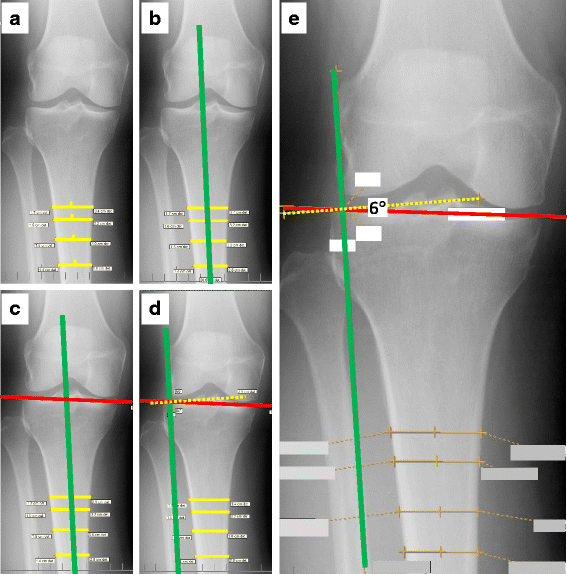Coronal tibial slope is associated with accelerated knee osteoarthritis: data from the Osteoarthritis Initiative
- PMID: 27432004
- PMCID: PMC4950083
- DOI: 10.1186/s12891-016-1158-9
Coronal tibial slope is associated with accelerated knee osteoarthritis: data from the Osteoarthritis Initiative
Abstract
Background: Accelerated knee osteoarthritis may be a unique subset of knee osteoarthritis, which is associated with greater knee pain and disability. Identifying risk factors for accelerated knee osteoarthritis is vital to recognizing people who will develop accelerated knee osteoarthritis and initiating early interventions. The geometry of an articular surface (e.g., coronal tibial slope), which is a determinant of altered joint biomechanics, may be an important risk factor for incident accelerated knee osteoarthritis. We aimed to determine if baseline coronal tibial slope is associated with incident accelerated knee osteoarthritis or common knee osteoarthritis.
Methods: We conducted a case-control study using data and images from baseline and the first 4 years of follow-up in the Osteoarthritis Initiative. We included three groups: 1) individuals with incident accelerated knee osteoarthritis, 2) individuals with common knee osteoarthritis progression, and 3) a control group with no knee osteoarthritis at any time. We did 1:1:1 matching for the 3 groups based on sex. Weight-bearing, fixed flexion posterior-anterior knee radiographs were obtained at each visit. One reader manually measured baseline coronal tibial slope on the radiographs. Baseline femorotibial angle was measured on the radiographs using a semi-automated program. To assess the relationship between slope (predictor) and incident accelerated knee osteoarthritis or common knee osteoarthritis (outcomes) compared with no knee osteoarthritis (reference outcome), we performed multinomial logistic regression analyses adjusted for sex.
Results: The mean baseline slope for incident accelerated knee osteoarthritis, common knee osteoarthritis, and no knee osteoarthritis were 3.1(2.0), 2.7(2.1), and 2.6(1.9); respectively. A greater slope was associated with an increased risk of incident accelerated knee osteoarthritis (OR = 1.15 per degree, 95 % CI = 1.01 to 1.32) but not common knee osteoarthritis (OR = 1.04, 95 % CI = 0.91 to 1.19). These findings were similar when adjusted for recent injury. Among knees with varus malalignment a greater slope increases the odds of incident accelerated knee osteoarthritis; there is no significant relationship between slope and incident accelerated knee osteoarthritis among knees with normal alignment.
Conclusions: Coronal tibial slope, particularly among knees with malalignment, may be an important risk factor for incident accelerated knee osteoarthritis.
Keywords: Alignment; Bone; Knee; Osteoarthritis; Radiography.
Figures


Similar articles
-
The varus alignment and morphologic alterations of proximal tibia affect the onset of medial knee osteoarthritis in rural Japanese women: Case control study from the longitudinal evaluation of Matsudai Knee Osteoarthritis Survey.J Orthop Sci. 2016 Mar;21(2):166-71. doi: 10.1016/j.jos.2015.12.002. Epub 2016 Jan 14. J Orthop Sci. 2016. PMID: 26778626
-
Coronal alignment on the single-limb stance radiograph in posterolateral rotatory instability, osteoarthritis and healthy knees.Knee. 2017 Jan;24(1):63-69. doi: 10.1016/j.knee.2016.09.003. Epub 2016 Sep 28. Knee. 2017. PMID: 27692866
-
Knee alignment does not predict incident osteoarthritis: the Framingham osteoarthritis study.Arthritis Rheum. 2007 Apr;56(4):1212-8. doi: 10.1002/art.22508. Arthritis Rheum. 2007. PMID: 17393450
-
Osteoarthritis prevention.Curr Opin Rheumatol. 2011 Mar;23(2):185-91. doi: 10.1097/BOR.0b013e32834307eb. Curr Opin Rheumatol. 2011. PMID: 21206274 Free PMC article. Review.
-
The Natural History of Lower Extremity Malalignment.J Pediatr Orthop. 2019 Jul;39(Issue 6, Supplement 1 Suppl 1):S14-S19. doi: 10.1097/BPO.0000000000001361. J Pediatr Orthop. 2019. PMID: 31169641 Review.
Cited by
-
Epidemiology of osteoarthritis.Osteoarthritis Cartilage. 2022 Feb;30(2):184-195. doi: 10.1016/j.joca.2021.04.020. Epub 2021 Sep 14. Osteoarthritis Cartilage. 2022. PMID: 34534661 Free PMC article. Review.
-
Pathological, Morphometric and Correlation Analysis of the Modified Mankin Score, Tidemark Roughness and Calcified Cartilage Thickness in Rat Knee Osteoarthritis after Extracorporeal Shockwave Therapy.Int J Med Sci. 2022 Jan 1;19(2):242-256. doi: 10.7150/ijms.67741. eCollection 2022. Int J Med Sci. 2022. PMID: 35165510 Free PMC article.
-
Autologous versus synthetic bone grafts for the surgical management of tibial plateau fractures: a systematic review and meta-analysis of randomized controlled trials.Bone Jt Open. 2022 Mar;3(3):218-228. doi: 10.1302/2633-1462.33.BJO-2021-0195.R1. Bone Jt Open. 2022. PMID: 35285251 Free PMC article.
-
Large lateral tibial slope and lateral-to-medial slope difference are risk factors for poorer clinical outcomes after posterolateral meniscus root tear repair in anterior cruciate ligament reconstruction.BMC Musculoskelet Disord. 2022 Mar 14;23(1):247. doi: 10.1186/s12891-022-05174-3. BMC Musculoskelet Disord. 2022. PMID: 35287650 Free PMC article.
-
Accelerated Knee Osteoarthritis Is Characterized by Destabilizing Meniscal Tears and Preradiographic Structural Disease Burden.Arthritis Rheumatol. 2019 Jul;71(7):1089-1100. doi: 10.1002/art.40826. Epub 2019 May 21. Arthritis Rheumatol. 2019. PMID: 30592385 Free PMC article.
References
-
- Neogi T, Niu J, Duryea J, Lynch J, Zhang Y. Identifying trajectories of medial joint-space width loss and associated risk factors. Osteoarthritis Cartilage. 2012;20(Supplement 1):S182–3. doi: 10.1016/j.joca.2012.02.281. - DOI
-
- Driban JB, Price LL, Eaton CB, Lu B, Lo GH, Lapane KL, McAlindon TE. Individuals with incident accelerated knee osteoarthritis have greater pain than those with common knee osteoarthritis progression: data from the Osteoarthritis Initiative. Clin Rheumatol. 2015;35:1565–71. doi: 10.1007/s10067-015-3128-2. - DOI - PMC - PubMed
Publication types
MeSH terms
Grants and funding
LinkOut - more resources
Full Text Sources
Other Literature Sources

